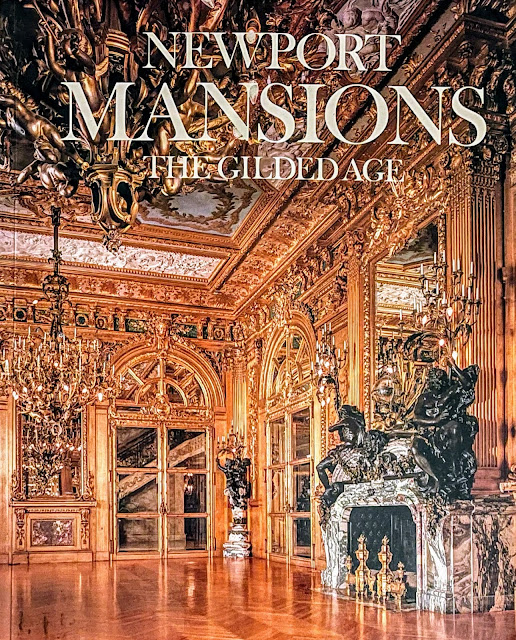The most imposing “cottage” erected in the ‘50s, Chateau-sur-Mer, is an Italianate stone villa constructed by a New Yorker, China-trade merchant William S. Wetmore. It was the setting for the first of Newport’s spectacular parties - a fete champêtre Wetmore hosted in 1857 to which he invited 3000 guests.
By the 1860s, it was not fashionable to stay at a Newport hotel for the season: one must own or rent a cottage. Most of the bigger hotels closed while more cottages were being built. Due to the Civil War, the Southern contingent at Newport was depleted and cottagers hailing from New York and Boston dominated summer society.
In stating this, however, one must not lose sight of the fact that Newport attracted not only America's financial elite, but many of its most gifted artists and writers, diplomats, politicians and jurists, historians, educators, scientists and engineers, architects and collectors. The literary set, led by Julia Ward Howe. gathered at Newport in the summer. Even that colorful writer of Wild-West tales, Bret Harte, spent time in genteel Newport.
For those disinclined to partake of witty theatricals and bookish conversation, the Newport season was very much a season of sport. Both men and women enjoyed riding, coaching, tennis and croquet. Archery was a women’s sport. Fishing, sailing, polo and golf were men’s sports. Swimming was enjoyed by both sexes, but generally not together.
Newport cottages of the 1860s, ‘70s and early ‘80s were large, comforable and oriented to the out-of doors. In 1879, willful, ill-tempered James Gordon Bennett, Jr.- a yachtsman and rake and the owner of the New York Herald — built the Newport Casino op posite his Bellevue Avenue cottage as a place where people might visit, dine, hear band concerts and play tennis. The Casino was an instant success and remained a center of cottagers’ daytime activities for decades. The work of New York architects McKim, Mead & White, it established a vogue for informal, shingle-clad resort architecture inspired by the con temporary British Queen Anne style and American Colonial buildings. Within five years, however, an entirely different taste took over. Grand new cottages were built, hieratic and palatial in scale, and it was to be the very same McKim, Mead & White, and even more so Richard Morris Hunt, who would set the pace in designing princely residences. Their celebrated “cottages” of the late 1880s, ‘90s and early 1900s make Newport the place in America to experience the Gilded Age.
The rush to opulence began with a series of very large, late Gothic stone houses at Newport. They were quickly overshadowed by a residence designed by Richard Morris Hunt and built by William K. Vanderbilt, as an anniversary present for his wife: Marble House, true to its name, is a Neo-Classical pavilion clad in shimmering white marble and decorated with a profusion of richly tinted marble veneers, mantels and ornaments, set off by gold fit tings and trim. It is like an enormous, beautifully crafted jewel box, miraculously set down on a cliff by the sea. After the Civil War, a great many American fortunes, like the Vanderbilts’, had grown to Medicean proportions, and the proud possessors of these for tunes, familiar with both European society and Euro pean standards of domestic magnificence, set out to build on the Medicean model.
Marble House was soon eclipsed by The Breakers, summer home of W.K. Vanderbilt’s older brother, Cornelius II. The Breakers, again the work of Hunt, has never been surpassed. From an architectural stand point, nonetheless, several large later cottages, though less sumptuous, are equally interesting. The best of these are McKim, Mead & White’s Rosecliff and Horace Trumbauer’s The Elms. Summing up Newport at the turn of the century, a British visitor wrote to the Evening Mercury of Liverpool, “No words can convey an idea of the marvelous spectacle of well and graciously and artistically applied wealth which has harnessed to its aspirations the greatest architectural art of the country... The result is such a combination of natural and contrived beauty, open for the enjoyment of all, and cannot be seen on such terms anywhere else in the world.”
The particulars of Newport cottage life changed little between the 1890s and the 1920s. These were the halcyon years of the leisured class. But the tempo and formality changed substantially.
Although, in a sense, the Newport scene of popular imagination died with the Great Depression, it lives on and is perpetuated in the incomparable legacy of landscape and architecture which survives from the Gilded Age, from the earlier nineteenth century, and from the days of Newport's Colonial prosperity. To see Newport today —to visit the Point, Bellevue Avenue, Ocean Drive and Cliff Walk, to enter Hunter House or The Breakers or one of the other museum houses - is to come face-to-face with a unique and living heritage. — From the Newport Preservation Society’s “Newport Mansions,” with intro by David Chase, 1995
🍽Etiquette Enthusiast, Maura J. Graber, is the Site Editor for the Etiquipedia© Etiquette Encyclopedia

No comments:
Post a Comment
Note: Only a member of this blog may post a comment.